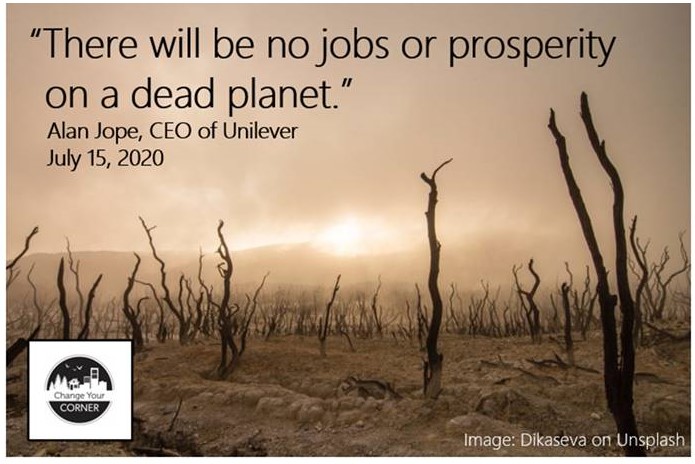For Earth Day, and every day
April 16, 2024
Ten truths and no lie
April 2, 2024
Some straight facts about carbon pricing
Phew – you’d have to be living under a rock to have missed all the recent hype about carbon pricing. But amid all the chatter, it’s not easy to discern truth. I suppose that’s because much of the discussion has been politically-driven, not fact driven; and because much of the discussion is happening online on platforms like Facebook, which tend to be terrible places for truth and honesty.
So in the interests of clarity and hopefully enabling more reasoned discussion, here are ten truths (to the best of my knowledge) about carbon pricing.
1. What most call a carbon tax is not actually a ‘tax’; it’s a carbon price, or more accurately a fee-and-dividend system. ‘Taxes’ are dollars collected by governments and then used to fund services like roads, schools and hospitals. The carbon price (or fee-and-dividend) is very different: money raised is divided up and rebated back equally to everyone. And it’s worth noting that no province is penalized to the benefit of another: “All direct proceeds from the federal pricing system are returned to the province or territory where they were collected.”
2. Those who pollute the most will pay the most – a principle I think most Canadians agree with. For example, those who drive huge and inefficient vehicles; those who live in huge or inefficient homes; those who travel a lot by air; those who burn a lot of fuel in boats and other ‘toys’… all behaviours that need to be discouraged in the battle against climate change. On the other hand, those who pollute the least will pay the least. For example, those who walk, bike or take transit; those who drive fuel-efficient vehicles and try to drive as little as possible; those who live in efficient homes; those who generate their own renewable energy… all behaviours that need to be encouraged in the battle against climate change.
3. 80 per cent of Canadians will receive more back by rebate than they pay by fee, according to analysis by Canada’s Parliamentary Budget Officer. How is that possible? Because those 80 per cent are essentially being topped up thanks to the other 20 per cent, who pay more fee than they receive back by rebate – and who, coincidentally, are also the wealthiest 20 per cent of our population and thus able to pay without hardship.
4. Carbon pricing maintains freedom of choice but gives everyone an incentive. We are blessed to live in a free country that allows us to make our own choices. However, choices that create more pollution or emissions are clearly detrimental to our society and world. Carbon pricing gives each of us an incentive to change behaviours and reduce our emissions so we come out further ahead when the rebate check arrives. Those who don’t wish to change can keep generating all the emissions they want; they’ll just find that society is now asking them to pay for the damage those emissions are doing.
5. Carbon pricing is not a major cause of inflation. The governor of the Bank of Canada has estimated that carbon pricing is responsible for .15 per cent inflation in Canada – a pretty small impact, considering our inflation rate has been as high as eight per cent in recent years. An economist at the University of Calgary, factoring all impacts on the food supply chain, including transportation, has concluded that the impact of carbon pricing on food prices is less than one per cent. If carbon pricing truly were a major cause of inflation, it’s logical that i) inflation rates would not be coming down in Canada (they are); and ii) inflation would not be a problem in countries without a carbon price (it is).
6. Carbon pricing is the cheapest way to reduce emissions because it puts the choice back to us, and we’re very good at being creative and innovative when it’s in our interest. That’s better – and cheaper – than regulations that tend to be narrow and rigid, and need to be enforced.
7. Economists all over the world agree that carbon pricing is the cheapest, most efficient and best way to reduce emissions: from the prestigious London School of Economics to The Economist magazine to the OECD to the International Monetary Fund to the World Trade Organization to Canada’s EcoFiscal Commission, which last month published an open letter in support of Canada’s current carbon pricing system signed by more than 300 economists from across the country. The 2018 Nobel Prize for Economics was awarded to William Nordhaus for his work on… carbon pricing!
8. Carbon pricing promotes renewables because every time the cost of fossil fuel energy goes up, the economic case for renewables like wind and solar gets better.
9. Starting small and ramping up slowly makes sense, as it cushions any economic impacts and enables people and businesses to plan ahead – for example, what their next vehicle will be. Canada’s carbon price started at $20 per tonne of emissions in 2019, and will be rising in an established and predictable way to $170 per tonne in 2030.
10. Doing nothing has an enormous cost. Here in New Brunswick, a windstorm last December knocked out power for days, wiping out any profit NB Power may have hoped to have for the year; and two torrential downpours of nearly 100 mm in the past month flooded the Town of Sussex and parts of Charlotte County. As former Quebec Premier Philippe Couillard said a decade ago, “Nobody talks about the cost of not fighting climate change. This cost is passed to citizens too, whether it’s health care, coastal erosion or spectacular weather events. This is hugely expensive for our society.”
It’s true that carbon pricing isn’t a perfect solution – but it’s one of the most important tools in the chest of climate change policy solutions. Hopefully the points above help make that clear!
Do you have a question not addressed above? Please let me know, and maybe I can help answer it in a future Green Ideas!
They’re not as cool as you think
March 19, 2024
Six reasons not to get that pickup truck
Thinking about buying a pickup truck? Here are six reasons to think again:
- They’re expensive to buy: if you want anything but the bare bones, expect to put down a ton of money – way more than you’d pay for a typical EV.
- They’re really expensive to own: with today’s gas prices, you can expect to spend well over $100 on every fill up, and that will only get worse as gas prices climb. That’s a lot to pay for a glorified commuter vehicle, which is functionally what most pickup trucks are. (The fuel cost per kilometer of a typical truck is eight times that of a typical EV. Eight times!)
- They take up a lot of space: some barely fit in garages or standard parking spaces. They can be pretty hard to manoeuvre in tight places like parking garages too.
- They’re not all that practical: the cab’s not especially suited to family needs, and the box is too short for plywood. Plus everything is a higher lift, including yourself. Plus anything theft-worthy needs to be kept in the cab (unless you want to lay out even more cash for a lockable tonneau).
- They’re the main reason why Canada has the least efficient motor vehicle fleet in the world, and why transportation emissions are such a large share of our total emissions.
- Honest, you won’t really be that cool: my wife chuckles at ego-stroking truck names like Maverick, Raptor, Rebel and Warlock. “They’re not rebels, they’re conformists; everybody’s got one of those!”

After a pandemic-related hiatus, the lots at my local dealerships are once again dominated by pickup trucks looking for buyers. Hopefully the above reasons are enough to demonstrate why one of them shouldn’t be you! (And if enough of us do, perhaps manufacturers will take note and focus on more practical, sustainable vehicles.)
The huge emissions from an under-the-radar source
March 5, 2024
Surprisingly, it’s nitrogen fertilizer – and it affects you!
There’s a good chance you’ve never heard of German chemists Fritz Haber or Carl Bosch – yet they’ve probably changed our world more than anyone else.
A little over a hundred years ago, they developed the Haber-Bosch process, an industrial procedure that captured nitrogen from the atmosphere and turned it into ammonia – a key ingredient of agricultural fertilizer. It suddenly enabled a huge increase in global food production, which in turn contributed to an explosion in our human population. Fritz Haber’s first prototype produced half a cup of ammonia per hour; today, 240 million tonnes of ammonia are produced each year globally.
All good, right? Except that the Haber-Bosch process uses natural gas – a LOT of it – to the point where:
- The production of one tonne of ammonia results in three tonnes of carbon dioxide emissions
- The Haber-Bosch process generates nearly two per cent of global emissions, more than the annual emissions of Germany. If Haber-Bosch were a country, it would be the world’s eighth largest emitter.
So what’s the point to all of this?
- Nitrogen fertilizers are essential to the industrial food production systems we’ve become dependent upon; we’d have a hard time feeding ourselves without them.
- Yet, they are enormous sources of the emissions that are driving climate change.
- So we need to use them as wisely and cautiously as possible.
- Which means we should probably use them as sparingly as possible, for food production only, and not waste them on non-food crops.
Which comes to the real point. The biggest non-food crop in our country, if not the world, is lawn: watered, mown – and typically fertilized with nitrogen. Ironically, watering and fertilizing make it grow faster – which means it needs to be mown more often. (And just to clarify: the extra growth caused by the fertilizer comes nowhere near to offsetting the carbon footprint of the fertilizer – or the gas-powered lawn mower.)
Fortunately, as pointed out in this optimistic and insightful story, our lawns are something each of us has complete control over. We get to decide.
So this spring, please make this simple resolution: don’t use nitrogen fertilizers on your lawn. If every Canadian did this simple and easy thing, we’d put a nice dent in emissions. And we’d probably have more time for summer fun, because we’d be spending less time mowing.

PS How to recognize whether a fertilizer contains nitrogen?
- Look for the words ‘ammonium nitrate’ or ‘urea’, the most common nitrogen fertilizers derived from Haber-Bosch
- Most fertilizers are labelled with three numbers (IE 34-0-0 or 18-45-0) that represent their percentage of nitrogen, phosphorus and potassium respectively. A high first number means a lot of Haber-Bosch derived nitrogen. Organic fertilizers with low first numbers are perfectly fine, because their nitrogen comes from natural sources like compost.
“Show me the money!”
February 21, 2024
Why we should think twice on Small Modular Nuclear Reactors
“Show me the money!” football player Rod Tidwell (Cuba Gooding Jr) yelled to his agent Jerry Maguire (Tom Cruise) in the movie of the same name. It was his way of asking for proof that the agent would actually do what he was promising he’d do. “Show me the money!” he shouted repeatedly, imprinting that line into popular culture.
In a world scrambling to transition away from oil, coal and natural gas, Small Modular Nuclear Reactors (SMRs) are often held up as potential solutions. They are nuclear reactors that are:
- Small in size relative to conventional nuclear power plants. Whereas New Brunswick’s Point Lepreau Nuclear Generating Station can produce 660 megawatts of power, the small modular reactors under development here are expected to generate 100 to 300 megawatts.
- Modular, meaning that instead of being built entirely on a site from scratch, they will have assemblies or ‘modules’ manufactured off-site and brought in – kind of like a modular home that is brought pre-assembled to a building lot and placed onto a prepared foundation.
A potential of advantage of some SMR designs is that they can use spent fuel (AKA nuclear waste) from conventional reactors such as Point Lepreau as their fuel source – potentially solving two problems at once. Other SMRs do produce nuclear waste, which is highly radioactive and, like waste from conventional nuclear plants, must be stored safely for centuries.
Another advantage of nuclear power is that it is ‘baseload’: a utility can normally count on it 24 hours a day, 365 days a year. That gives nuclear an advantage over renewables like wind and solar, which require backup for when the wind isn’t blowing or the sun isn’t shining.
Like renewables, nuclear power doesn’t produce any greenhouse gas emissions – hence its categorization as ‘non-emitting’.
But this is where ‘show me the money’ comes in:
- How much will they cost? Small Modular Reactors are still under development, with none currently operational anywhere in North America. That means considerable uncertainty remains about how the technology will work – and that means plenty of uncertainty about the final cost of construction and the eventual cost of electricity. New Brunswick’s two experiences with nuclear power – the construction and then the refurbishment of Point Lepreau – have both resulted in massive cost overruns borne by NBers. If the companies constructing SMRs are so confident in their technology, shouldn’t they be able to give a guaranteed price for the power they’ll provide before the first shovel hits the ground? Ironically, the opposite has happened: New Brunswick’s government is requiring NB Power to buy electricity from the first two SMRs to be constructed here, regardless of the price.
- Taxpayers have footed the bill: So far, much of the SMR development work happening in this province has been funded by tens of millions of taxpayer dollars from both the provincial and federal governments – money that could have otherwise built considerable wind and solar capacity.
- Will their power ever be cost-competitive with wind and solar? According to the Lazard Levelized Cost of Energy, a global standard for comparing the cost of energy from various sources, wind and solar power, even when equipped with storage technologies to compensate for their intermittency, are among the cheapest sources of new electricity. Nuclear power, on the other hand, is listed as among the most expensive.
- It’s unlikely they’ll be ready on time: According to the latest report of the UN’s Intergovernmental Panel on Climate Change, global emissions need to be reduced 43 per cent below 2019 levels by 2030, just six years from now, if we are to limit warming to 1.5 degrees C. It’s highly unlikely that SMRs could ever be ready by then, and putting our faith in them would seem a bit like taking off in an airplane to a destination without an airport on the promise that there will be one there by the time we arrive. Contrast that with wind and solar, which are proven, cost-effective and scalable today.
It’s true that past inaction on climate change has pushed us to a point where no potential alternative to fossil fuels can be ignored. However, Small Modular Nuclear Reactors remain rife with uncertainty. So we’d probably all be wise to view them very carefully through a lens of rational analysis.
Show me the money; show us all the money.
If you ‘follow your money’, where does it lead?
February 21, 2024
Choose to invest sustainably this RRSP season (and always)
“Follow the money,” informant Deep Throat whispered in All the President’s Men, a movie about corruption in the Nixon era. That now-famous line speaks to a basic truth in our world: money makes things happen, and lack of money prevents things from happening.
Energy is a good example. Fossil fuel companies would never be able to extract oil, coal and natural gas without the backing of financial institutions – which in turn have made tons of money by bankrolling the sector. And here’s a devastating reality: banks continue to finance new fossil fuel development, even as the climate change consequences of burning fossil fuels become clearer, and even in spite of the ambitious emission reduction targets of the 2015 Paris Accord. A global report card by the Rainforest Action Network found:
- US$5.5 trillion have been invested in the fossil fuel industry since the signing of the Paris Climate Accord by 60 of the planet’s largest banks – the vast majority of it by the Top 20.
- All of Canada’s Big Five banks are in that Top 20. Royal Bank of Canada is the fifth largest fossil fuel investor in the report card, followed by Scotiabank (9th); TD (10th); Bank of Montreal (15th); and CIBC (19th).
Imagine where we’d be if that $5.5 trillion had instead been invested in clean, renewable energy.
So what can you do? Most of us have retirement portfolios or pensions, and it’s RRSP contribution time. You can steer your money to where it does the most good and least harm by:
- Learning as much as you can about sustainable investing (here’s a nice overview) and corporate Environmental, Social and Governance (ESG) scores (here’s a nice overview); or subscribing to the free Green Money Journal.
- Asking your advisor to divest your portfolio of fossil fuel holdings and instead seek out viable sustainability-oriented investments (and there are more to choose from all the time).
- If you’re a client of one of Canada’s Big Five banks, letting your advisor know you’re not happy with their support of fossil fuels, and asking them what their bank’s plans are to divest. Remind them you have options.
- Moving your business to a more sustainability-minded financial institution if you’re not happy with your bank’s divestment plans.
- If you’re ready to take things a step further, joining a campaign like Fossil Banks: No Thanks to pressure banks or Shift to pressure pension funds (including the Canada Pension Plan fund, in which all Canadians have a stake) to divest of fossil fuels and shift to investments that fight climate change.

If you haven’t already, now’s a perfect time to start making wise, sustainable investment choices, so that when you ‘follow your money’, you’ll find it’s making good things happen!
Paying for power for the first time since summer
January 23, 2024
An update on our home’s solar power system
If you’re a longstanding subscriber, you probably know that I’m a big fan of solar panels to generate emission-free electricity and save money. You may also know that we’ve had solar here at home for the past few years. Here’s an update.
First, a quick backgrounder:
- In late 2020, we installed our first solar system, consisting of a ground-mount (IE a rack in our yard) with 6 KW of solar panels plus a battery backup system
- Our array is grid-tied, so we’re still connected to NB Power. Anytime our solar panels are producing more power than we use, the surplus automatically gets sent out NB Power’s lines; and we automatically get power back from NB Power anytime we’re using more than the panels are producing (like at night).
- Our system is net-metered, meaning that our power meter keeps track of any surplus power we send out the line, building up a credit we can draw back anytime we need more power than our panels are providing.
- The system’s battery backup automatically takes over during power failures, with barely a flicker of our lights (my favourite feature).
Results from that first array:
- In its first two years of operation, our solar system provided about two-thirds of the power we used to run our home and charge our EV.
- Equally important, it has seamlessly provided us with backup electricity through several power failures – including through the two-day outage we experienced after a hurricane-like storm blew through NB December 18.
Because our system has worked out so well, we added a second array of panels last June – this one on our garage roof – with the hope that the two systems combined will take us to net-zero on an annualized basis.
Results from the combined arrays:
- Since the second system was installed in June, the two arrays have generated more than we have used, building up a credit with NB Power.
- That credit has carried us through the fall to the end of December (as shown in the graphic below, snipped from our last power bill).
Alas, this month we’ll be using up the last of the credit and then paying for purchased electricity again – but for the first time since June, which isn’t too bad.

The good news: solar panels actually love cool temperatures, so on bright days like yesterday, our original array, pictured above, produced a near-perfect ‘bell curve’ of power, and had us into surplus territory for a good part of the day.
More good news: the federal government offers great incentives for the installation of solar systems, as do most provinces; NB’s programs are here.
If you haven’t looked into solar yet, you owe it to yourself – for cost and emissions savings (resilience and self-sufficiency too)!
One last point: I’m tentatively planning another Open House this spring, date to be confirmed, for anyone who’d like to see a solar system up close. If you’re interested, please just hit reply to let me know, or click on the icons below to find me on social media.
Suggestions from a reader!
Thanks to subscriber Grace Beazley for sharing the following additions to December 27th’s Make 2024 your “Sustainability Big Year” action list:
- Reduce the length of my shower to __ minutes
- Use cold water for washing my clothes
- Buy my laundry soap at stores where I can refill my reusable containers
Heat Pumps 101
January 9, 2024
A closer look at one of the best ways to save AND reduce emissions
Heating accounts for about 60% of the energy used in Canadian homes and buildings. It’s expensive, and it can be a huge source of emissions too, especially if that energy comes from natural gas or coal-fired electricity.
Heat pumps to the rescue! They’re super efficient – and current incentive programs make them really affordable too. Plus – the International Energy Agency estimates that widespread adoption by 2030 could reduce global greenhouse gas emissions by at least 500 million tonnes a year – that’s equal to the annual emissions of all cars in Europe today!
So here, in point form, is a short primer about heat pumps.
- How they work: it’s helpful to imagine buildings with heat pumps as inside-out refrigerators. Whereas a fridge is a box where the inside gets cooled and heat is expelled out through the coils on the back of the box, a building with a heat pump is a box where the outside gets cooled, and heat is expelled into interior spaces.
- There are two types: air-source heat pumps extract heat from outside air by cooling it several degrees. They then release that heat into interior spaces. Ground-source heat pumps (also called geothermal heat pumps) use wells or a system of underground coils to extract heat from underground in the same way; and then release that heat into interior spaces. Some also produce hot water.
- Air-source heat pumps can be ductless or ducted: ductless heat pumps (also known as mini-splits) have their indoor units mounted on a wall and release heat directly into the room in which they are located. Ducted heat pumps (also called central heat pumps) distribute heat throughout a building via a system of ducts.
- Super efficient: whereas baseboard heaters produce just one unit of heat for every unit of electricity used, heat pumps can produce up to five units of heat for every unit of electricity used. That explains why they can be such money-savers! (The fine print: keep reading for more on cold temperature performance of air source heat pumps.)
- Operating range: today’s air-source heat pumps work well to temperatures as low as -25 degrees C; some even work to as low as -30 degrees C. However, it’s important to note that their efficiency does drop the colder it gets (because the colder air is, the harder it is to extract heat from it). Ground-source heat pumps are consistently very efficient all year round because temperatures underground are very stable.
- Advantages of air-source heat pumps: less expensive to install than ground-source; ductless in particular are easy and inexpensive retrofits for homes and buildings with baseboard heaters.
- Advantages of ground-source heat pumps: very efficient year-round; able to provide domestic hot water as well for further savings.
- Some maintenance required: all heat pumps require basic maintenance like regular cleaning of filters, and perhaps annual servicing by a qualified contractor.
- Cooling, a double-edged sword: most heat pumps have the ability to provide cooling as well as heating. The downside: summer air conditioning may offset some of winter heat savings.
- Incentives: check out generous federal incentives under the Canada Greener Homes Initiative, the federal Oil to Heat Pump Affordability Program and for your province (for New Brunswick, here).
For a deeper dive, check out this guide from Natural Resources Canada, or this explanation complete with cool graphics!
Fill-in-the-blank New Year’s Resolutions
December 26, 2023
Make 2024 your Sustainability Big Year
In the birdwatching world, a Big Year is a personal challenge a birder sets for themselves to spot as many different species of birds as possible in a single calendar year. Among avid birders, it’s a pretty serious undertaking – there are official rules, and it was even the theme of a 2011 movie.
2023 was a year for the record books, with a head-spinning array of climate impacts underlining the need for urgent action by each of us. So why not resolve to make 2024 your Big Year for Sustainability, by committing to as many actions as possible? New Year’s is a perfect time to get started, and here is a checklist of opportunities. Some are simple and can be done quickly (let’s call those chickadees). Others will take a bit more commitment and time (let’s call those caracaras). But just as every bird sighted counts toward a birding Big Year, every action taken counts in a Sustainability Big Year. So let’s get started!
For 2024, I resolve to:
- Turn off lights whenever I leave a room
- Recycle everything possible (and not forget to put it out on recycling day!)
- Keep organics waste out of my trash, and either compost it myself or give it to someone who gardens
- Generate no more than ___ bags of trash in 2024
- Buy no more than ___ bottles of water this year, with the aim of making that zero in 2025 (for big $ savings too!)
- Avoid using drive-throughs for coffee, fast food, banking or anything else
- Turn my vehicle’s engine off and stop wasting fuel by idling
- Learn and practice fuel-saving eco-driving techniques (for big $ savings)
- Use my vehicle’s fresh air settings or just open the windows instead of using air conditioning
- Get a spork and carry it with me so I don’t need to use plastic single-use cutlery
- Place a bag with reusable tableware and plastic containers in my car so I don’t need to use paper or foam plates or take-out containers when I eat out
- Start making my coffee at home (ideally using rainforest friendly, fair-trade coffee) (for big $ savings too)
- Start shifting to a more plant-based diet, with the aim of reducing my red meat consumption by ___% by the end of 2024 (for big $ savings too)
- Start a garden this summer to grow some of my own food
- Shower every ___ days instead of daily
- Shop thrift or second-hand stores for ___% of the clothing and consumer products I’ll buy this year
- Take public transit or carpool at least ___ times a week (for big $ savings too)
- Choose walking or biking over driving whenever possible
- Use a clothesline instead of a clothes dryer at least during the spring, summer and fall
- Get an electric lawn mower
- Borrow a power meter from my local library, and use it to learn how much power different items in my home use, so I can improve my ‘energy literacy’ and know where I can save the most
- Make upgrades to my home, such as air sealing and adding insulation (taking advantage of federal and provincial incentives)
- Educate myself on the benefits and savings of electric vehicles, and start planning that my next vehicle will be electric
- Learn more about my carbon footprint by taking a quiz like this or this
- Spend more time outdoors, and go for at least ___ walks a week
- Write or call my federal, provincial (or state) and local elected leaders at least ___ times to advocate for more environmental and sustainability programs, policies and laws
Over to you – and best wishes for a Big Year of Sustainability in 2024!
PS How many did you check? Do you have suggestions to add? Why not let me know so I can share them in a future Green Ideas?
‘Twas the Week Before Christmas
December 12, 2023
11th Hour Sustainable Christmas ideas
Somehow, in spite of my best intentions every year, Christmas shopping ends up being a last-minute affair. It’s made more challenging by the fact that we really don’t want or need more stuff in our home; we just want a fun, sustainable holiday season with some uncluttered, quality time together.
If you’re like me, don’t despair! Check out this link for over 50 eco-friendly tips for a waste-reduced, sustainable, more affordable holiday season. It covers everything from gifts to decorations to food. And if you prefer watching and listening over reading, why not check out this awesome Facebook page by the Foremans, NB’s representatives in the Canadian Geographic Live Net Zero Challenge, for fun, short videos about sustainability through the holidays and beyond?

Happy holidays, and thanks for being a Green Ideas subscriber!











